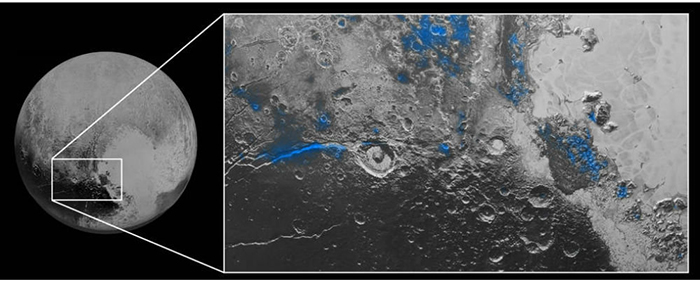NASA reveals Pluto

“The striking blue tint tells us about the size and composition of the haze particles,” said new Horizons team researcher Carly Howett. “A blue sky often results from scattering of sunlight by very small particles. On Earth, those particles are very tiny nitrogen molecules. On Pluto they appear to be larger — but still relatively small — soot-like particles we call tholins.”
This photo shows Pluto`s largest moon Charon, left, with a captivating feature, a depression with a peak in the middle, shown in the upper left corner of the inset image at right.
The NASA team thinks the tholin particles form high in the Plutonian atmosphere, where what ultraviolet sunlight from over three billion miles away that washes the planet, breaks down and ionizes nitrogen and methane molecules. Recombination of the broken down molecules creates complex macromolecules. The more complex molecules grow until volatile gases condense, then coat surfaces with frost.
This process is believed to be what contributes to the frosty red hues on the Plutonian surface.
New Horizons also discovered many small regions of water ice, via the Ralph spectral composition mapper.
This image combines blue, red and infrared images taken by the Ralph/Multispectral Visual Imaging Camera (MVIC). Pluto’s surface sports a remarkable range of subtle colors, enhanced in this view to a rainbow of pale blues, yellows, oranges, and deep reds.
“Large expanses of Pluto don’t show exposed water ice,” said science team member Jason Cook, of SwRI, “because it’s apparently masked by other, more volatile ices across most of the planet. Understanding why water appears exactly where it does, and not in other places, is a challenge that we are digging into.”
The photos show that the water ice seems to manifest around craters, crevasses and mountainous regions.
“I’m surprised that this water ice is so red,” says Silvia Protopapa, a science team member from the University of Maryland, College Park. “We don’t yet understand the relationship between water ice and the reddish tholin colorants on Pluto`s surface.”















































